Marine Life & Conservation Blogs
Lionfish: a very spiny problem!

For anyone who has been diving in the Caribbean in the last few years, you have probably heard of the lionfish problem. Having taught marine biology & conservation in the Caribbean for several years, it’s a question I get asked about a lot. This blog explains some of the facts about lionfish and what we can do to help our reefs:
- Where should they be?
- How did they get into the Caribbean?
- What is all the fuss about?
- What you can do to help the reefs?

Where should they be?
Lionfish are a beautiful predatory fish, native to the Indian and Pacific Oceans and the Red Sea.
In their native habitat the lionfish is great to observe and photograph. They are not very common as they have natural predators that keep population down and in balance with the other reef fish (Density/hectare in the Pacific is ~20).
How did they get into the Caribbean?
Unfortunately since 1992, two species of lionfish (Pterois volitans & Pterois miles) are now found in the Atlantic Ocean and the Caribbean Sea, where they are an invasive species. The theory is that captive lionfish were released or escaped off the coast of Florida and the population has spread. Lionfish established themselves in the Caribbean in less than 3 years and range from North Carolina to South America including the Gulf of Mexico. From a few individuals in 1992 the population has now spread out of control to become a major problem in the ecosystem (Density/hectare in Caribbean ~398 in 2012).
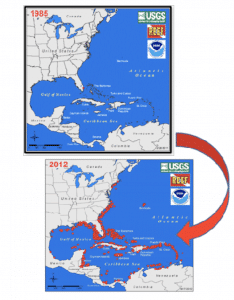
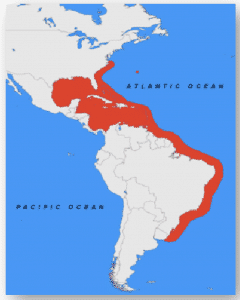
What is all the fuss about?
Why are lionfish an issue?
To understand the issue, we first need to know a bit about the fish.
Lionfish biology:
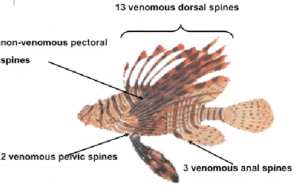
They have venomous tissue within their spines for protection and are generalist carnivores. Adults can grow up to 42cm and have a lifespan of 5-10 years. They become sexually mature in less than a year and spawn in pairs. Females can release 30,000 eggs at one time. Enclosed in a mucus layer, the eggs float to the surface. In a few days the mucus dissipates and the eggs are released to be dispersed by ocean currents.
Habitat & ecology
Lionfish inhabit all marine habitat types (reefs, lagoons, mangroves, sea grass beds, sand patches and artificial substrates) and can handle tropical temperatures all the way down to 10°C. They can also live at a huge range of depths (from shoreline to over 300m or 1000 feet), though they tend to be territorial, so may remain in the same area for up to 7 months. They appear to be attracted to cleaning stations.
So why are they a problem?
Lionfish have no natural predators in the Caribbean. The density per hectare of invasive lionfish is around 20x higher than in their native waters. They consume over 70 species of fish and many invertebrate species and can eat prey up to half their body length (basically they can eat pretty much anything!). This makes them top predators along with sharks, rays and groupers. By colonising mangroves and sea grass beds they pose a major threat to juvenile fish (this is where lots of baby fish live until they are big enough to survive out on the reef).
On heavily invaded sites, lionfish have reduced their fish prey population by up to 90% and continue to consume native fishes at unsustainable rates. Many reefs have been decimated of the native reef fish as the lionfish consume until supply of fish has run out. Once the food has run out, lionfish can survive for 12 weeks with no food, so can move on to other feeding grounds. Reefs without fish don’t function, so the coral also starts to suffer.
Invasive lionfish reproduction occurs throughout the year and as frequently as every 4 days (whereas native Indo-Pacific lionfish breed only once a year!). This means an invasive female lionfish can lay over 2 million eggs/year in the Caribbean. And unlike in the Indo-Pacific, many of these eggs will survive to adulthood. This means the populations are increasing at a phenomenal rate (700% in 4 years!).
Where lionfish containment programs operate, the deep dwelling fish can be very hard to get to in order to kill or capture. So lionfish pose a threat to the integrity of the reef food web and can have wide reaching impacts on commercial fisheries, tourism, and overall coral reef health.
What you can do to help the reefs?
Educate others and spread awareness of lionfish.
EAT THEM!! They are a delicious delicacy (see RECIPES below!). Also eating this fish reduces pressure on fish stocks of native species.
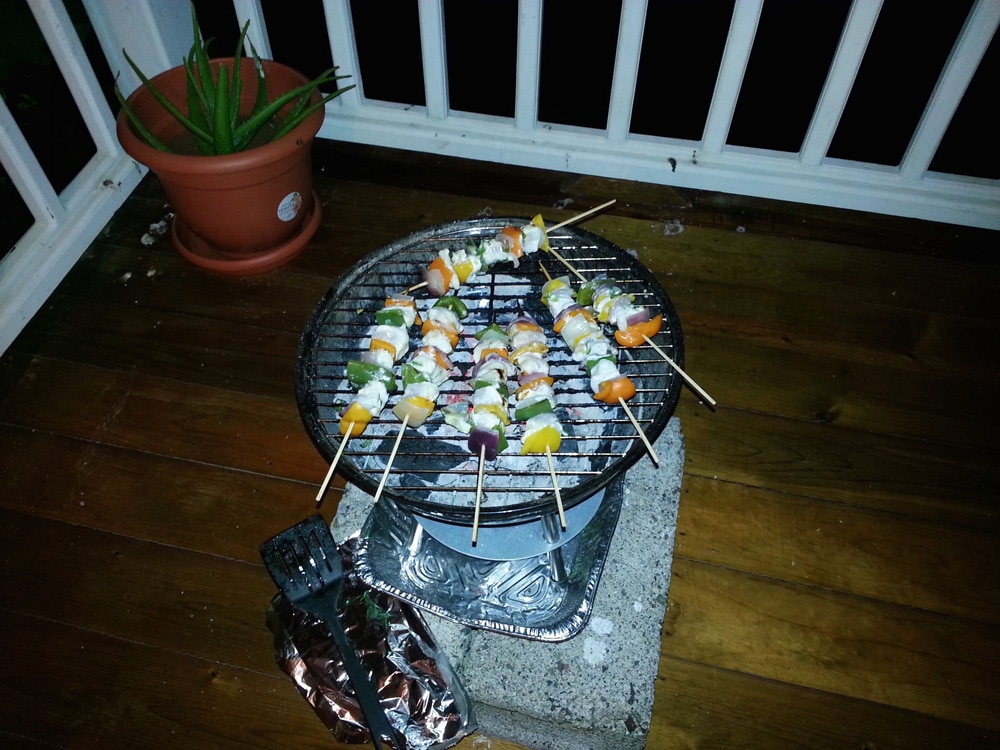
Encourage local restaurants to serve Lionfish and promote consumption by community members.
We need to be the main predator and keep dive sites as free of Lionfish as possible. Though we cannot get all of them, reducing the numbers on the coral reef and shallow water can really help native fish species and coral health.
Lionfish removal:
Spearing lionfish is quick and safe if done properly (Hawaiian Slings can be used very effectively). A tube container is recommended to store captured fish.
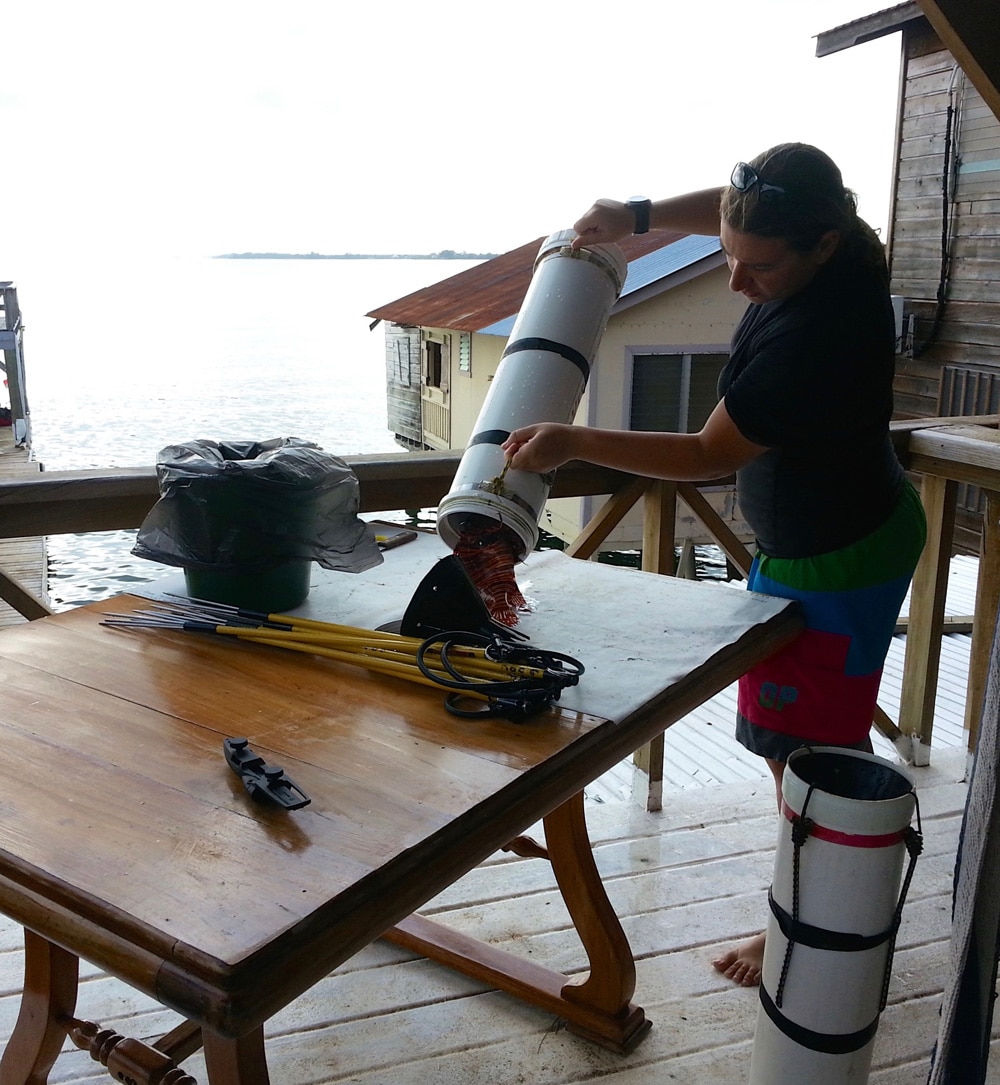
Many marine park authorities and islands have licensed spearing lionfish as local removal efforts can significantly reduce lionfish densities and subsequent impacts. Efforts are invaluable for supporting other conservation initiatives like management of marine protected areas, pollution control and fish stock rebuilding in order to help our reefs.
Try our favourite Lionfish Recipes! To see them click here.
- Island Lionfish Fry
- Lionfish Ceviche
- Lionfish Coconut Curry
- Coconut Lionfish with Spicy Mango Dip
- Marinara Lionfish Spaghetti
- Lionfish Tacos with Street Corn and Salsa
- Cajun Spiced Lionfish Fillets with Mango Salsa
- White Wine Lionfish
- Lionfish Sanganaki
- BBQ Lionfish: Kebabs and Parcels
Marine Life & Conservation Blogs
Book Review: Shells of the World

Shells of the World: A Natural History by M.G. Harasewych
Shells of the world is a guide to the world of marine, shelled molluscs. And what a varied and interesting world it is. Some of my favourite things to find on a dive are detailed in this book, including disco clams (or Electric File Clams as they are correctly names), the cephalopods, giant clams and sea hares. There are also many on my wish list, top of which is the Nautilus.
Each chapter provides a detailed description of the species, along with beautiful images. You can dive deeper and discover where they live, both with global distribution and the habitat they prefer. Learn about their diet, reproduction and diversity.
Having dipped in and out of this lovely book over the past few weeks, it has inspired me to learn more about this group of animals that we see on most divers, wherever we are in the world. Some of the shells are incredibly intricate and beautiful. I have always agreed with never collecting, or touching, marine life. The description of a certain set of cone shells should be a warning to those that are happy to pick up marine life! One of the cone shells has a local name called the cigarette snail. Why? Because once the venom is in your system from this animal, you only have time to smoke one cigarette before the affects of the venom are fatal!
What the publisher says:
Mollusks are invertebrate animals with a remarkable natural history and a rich fossil record, and their shells are prized for their breathtaking variety and exquisite beauty. Shells of the World provides a wide-ranging look at the incredible diversity of marine mollusks. An informative introduction outlines the lineages covered, followed by a directory section, split into classes, that profiles a broad selection of different taxa to give a sense of their sheer numbers and variety.
- Features hundreds of beautiful color photos, depicting both the live animals and their shells
- Discusses mollusk evolution, anatomy, life cycles, behavior, and ecology
- Describes unique characteristics, distribution, habitat, and size
- Provides valuable insights into the conservation of the world’s marine mollusks
- Ideal for malacologists and shell collectors everywhere
About the Author:
M. G. Harasewych is research zoologist emeritus and former curator in the Department of Invertebrate Zoology at the Smithsonian Institution’s National Museum of Natural History. A fellow of the American Association for the Advancement of Science, he is the author (with Fabio Moretzsohn) of The Book of Shells: A Life-Size Guide to Identifying and Classifying Six Hundred Seashells.
Book Details
Publisher: Princeton University Press
Hardcover
Price: £25
ISBN: 9780691248271
Published: 9th April, 2024
Blogs
The Ocean Cleanup Breaks 10,000,000 KG Barrier

The Ocean Cleanup, the global non-profit project, has removed a verified all-time total of ten million kilograms (22 million lbs.) of trash from oceans and rivers around the world – approximately the same weight as the Eiffel Tower.
To complete its mission of ridding the oceans of plastic, The Ocean Cleanup uses a dual strategy: cleaning up the Great Pacific Garbage Patch (GPGP) to remove the plastic already afloat in the oceans, while stopping the flow of plastic from the world’s most polluting rivers.
Through cleaning operations in the GPGP and in rivers in eight countries, the cumulative total of trash removed has now surpassed ten million kilograms. This milestone demonstrates the acceleration of The Ocean Cleanup’s impact, while underlining the astonishing scale of the plastic pollution problem and the need for continued support and action.
While encouraging for the mission, this milestone is only a staging point: millions more tons of plastic still pollute our oceans and The Ocean Cleanup intends to continue learning, improving and innovating to solve this global catastrophe.
This announcement comes as governments from around the world meet to continue negotiations to develop a new legally binding instrument to end plastic pollution at INC4 in Ottawa, Canada. Representatives of The Ocean Cleanup will be in attendance and the organization will be urging decision-makers to collaborate towards a comprehensive and ambitious global treaty which addresses plastic at all stages of its life cycle and in all marine environments worldwide, including in areas beyond national jurisdiction.
It is encouraging to see that the need for remediation is reflected in the various options for potential treaty provisions. It is essential that the final treaty contains clear targets for the remediation of legacy plastic pollution, and reduction of riverine plastic emissions.
Tackling plastic pollution requires innovative and impactful solutions. The treaty should therefore incentivize the innovation ecosystem by fostering innovations that make maximal use of data, technology and scientific knowledge – such as those designed and deployed by The Ocean Cleanup.
‘After many tough years of trial and error, it’s amazing to see our work is starting to pay off – and I am proud of the team who has brought us to this point.’ said Boyan Slat, Founder and CEO of The Ocean Cleanup. ‘While we still have a long way to go, our recent successes fill us with renewed confidence that the oceans can be cleaned.’
The Ocean Cleanup was founded in 2013 and captured its first plastic in 2019, with the first confirmed catch in the GPGP coming soon after the deployment of Interceptor 001 in Jakarta, Indonesia. After surpassing one million kilograms of trash removed in early 2022, the non-profit project has since progressed to the third iteration of its GPGP cleaning solution, known as System 03, and a network of Interceptors currently covering rivers in eight countries, with more deployments set for 2024.
About The Ocean Cleanup
The Ocean Cleanup is an international non-profit organization that develops and scales technologies to rid the world’s oceans of plastic. They aim to achieve this goal through a dual strategy: stemming the inflow via rivers and cleaning up the legacy plastic that has already accumulated in the ocean. For the latter, The Ocean Cleanup develops large-scale systems to efficiently concentrate the plastic for periodic removal. This plastic is tracked and traced through DNV’s chain of custody model to certify claims of origin when recycling it into new products. To curb the tide via rivers, The Ocean Cleanup has developed Interceptor™ solutions to halt and extract riverine plastic before it reaches the ocean. Founded in 2013 by Boyan Slat, The Ocean Cleanup now employs a broadly multi-disciplined team of approximately 140. The foundation is headquartered in Rotterdam, the Netherlands.
For more information, visit: theoceancleanup.com and follow @theoceancleanup on social media.
-

 News3 months ago
News3 months agoCapturing Critters in Lembeh Underwater Photography Workshop 2024: Event Roundup
-

 Marine Life & Conservation Blogs3 months ago
Marine Life & Conservation Blogs3 months agoCreature Feature: Swell Sharks
-

 Gear Reviews4 weeks ago
Gear Reviews4 weeks agoGEAR REVIEW – Revolutionising Diving Comfort: The Sharkskin T2 Chillproof Suit
-

 Blogs2 months ago
Blogs2 months agoMurex Resorts: Passport to Paradise!
-

 Blogs3 months ago
Blogs3 months agoDiver Discovering Whale Skeletons Beneath Ice Judged World’s Best Underwater Photograph
-

 News3 months ago
News3 months agoPADI Teams Up with Wellness Brand Neuro to Drive Ocean Change and Create a Blue State of Mind
-

 Gear Reviews3 months ago
Gear Reviews3 months agoGear Review: Oceanic+ Dive Housing for iPhone
-

 Marine Life & Conservation2 months ago
Marine Life & Conservation2 months agoSave the Manatee Club launches brand new webcams at Silver Springs State Park, Florida


















